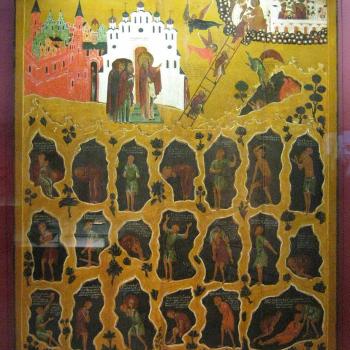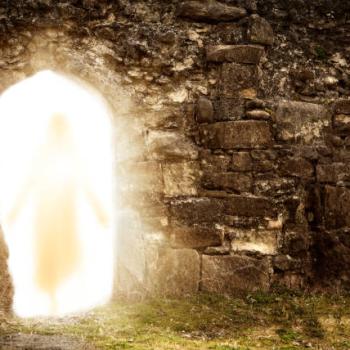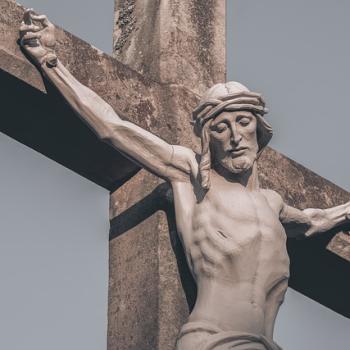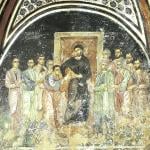
On Horsley’s Jesus and the Politics of Roman Palestine, Part 3
Richard A. Horsley brings the political situation of first-century Palestine out of the background and into focus as an important part of understanding Jesus. The resulting picture of Jesus stays true to the Gospels while making sense of Jesus’ career, especially its ending. Jesus’ politics can be ignored no longer or we’re not taking the incarnation seriously. Politics, economics, as well as some attitude toward the Ultimate are essential features of every human being, and Jesus, fully human, is no exception.
To understand Jesus’ politics, Horsley goes first to the political, economic, social, and religious world of Jesus’ first-century Palestine. Rome had conquered that world and had for some time been the dominant power. The previous post in this series developed Horsley’s view that the time and place were ready for a leader of resistance to Rome and renewal of the Israelite covenant. Horsley examines Jesus’ politics in word and act and makes the case that Jesus fit that expectation.
Jesus’ politics in his words and actions
Debt forgiveness and Jubilee
Perhaps the most important of Jesus’ politically and economically provocative words are the prayer he taught his followers to say. Jesus prayed for God’s Kingdom to come, as opposed to Caesar’s, and affirmed an important feature of that Kingdom – forgiveness of debts.
“Forgive us our debts as we forgive those who are indebted to us.” That provision of the Lord’s Prayer recalls Jesus’ first sermon in Luke’s Gospel:
The Spirit of the Lord is upon me because he has anointed me to bring good news to the poor. He has sent me to proclaim release to the captives and recovery of sight to the blind, to proclaim the year of the Lord’s favor. (Luke 4:18-29)
Jesus’ “year of the Lord’s favor” is good news to the indebted poor of Palestine. It was either the Sabbatical seventh year or the Jubilee 50th year. Either occasion, by ancient rule, was a time for forgiveness of debts. Scholars raise doubts whether that rule was being followed in Jesus’ time, or ever. But Horsley finds evidence in Josephus that the custom of debt forgiveness was in effect in the first century. (p. 118) He also cites the “prosbul,” a scribal “work-around” as another “important bit of evidence.” It was a way wealthy lenders could “bypass the officially recognized laws protecting peasants” who couldn’t pay off debts. There must have been something to “work around.”
Jesus featured debt in stories and moral teaching. He was in tune with one of the lively and controversial issues of the day.
Opposition to the Temple
Jesus’ attitude toward the religious establishment, particularly that of the Jerusalem Temple, made him some enemies. Pharisees from Jerusalem opposed Jesus’ mission in Galilee. Jesus pronounced God’s judgment against the Jerusalem leaders and their Temple. His prediction of the Temple’s destruction and his theatrical demonstration in the Temple, a so-called cleansing but actually a symbolic takedown, (see this post) sealed his fate.
Opposition to the Roman tax
The Temple only added to the oppression coming from the real earthly power in Palestine, Rome. Expropriating wealth through taxation was the basic purpose of Rome’s empire. Horsley says,
“While he did not tell the people not to yield up the tribute, for which he would have been subject to immediate seizure, Jesus stated simply and bluntly that the people did not owe tribute to Caesar” (p. 50-51).
Actually, what Jesus said was, “Render to the emperor what belongs to the emperor and to God what belongs to God.” All Israelites would have understood that everything belongs to God and nothing to the emperor. Jesus’ pronouncement didn’t save peasants any money, but there’s assurance in knowing one’s feelings match God’s law. One could believe that God would ultimately triumph, and many, in different ways, lent their assistance to God’s purpose.
Condemnations of the wealthy
“Woe to you who are rich…. It is impossible for a rich person to enter the Kingdom of Heaven.”
Jesus took care to include more than just Rome in his condemnations. It wasn’t just Rome taking the peasants’ heard-earned money. The rich class, including large land owners and Temple officials cooperating with Rome, primarily got that way by expropriation. We’d call them loan sharks. Money concerns make up a large percentage of Jesus sayings and parables. Jesus had his own remedies for those concerns. Herzog opines,
Jesus is creatively transformed the anger of the people about their exploitation into motivation for recommitment to cooperation and mutual support” (p.46).
Jesus’ work in the villages of Galilee
Cooperation and mutual support was a large part of Jesus’ prescription for peasant villages. A major difference between Jesus and John the Baptizer (and other would-be prophets) is in the locations of their work. John and other prophet-like leaders plied their trade in the hinterlands. People came to them in droves. But Jesus went where the people were, from village to village in Galilee. These places were facing widespread poverty and debt under Roman rule.
When Jesus sent out the 70 or 72 disciples on mission, it was precisely to those village communities. His message, the message the disciples were to take to the villages, was one of peace.
Into whatever house you enter, first say, ‘Peace to this household.’ (Luke 10:5)
But how can village communities remain peaceable when under such stress as imperial subjugation placed on them? Jesus had an answer, and he laid it out in his Sermon on the Plain (Luke 6) or on the Mountain (Matthew 5-7). Herzog calls this Jesus’ covenant-renewal speech. (P. 119)
A covenant for village survival
Jesus’ politics aimed at covenant renewal for the sake of the survival of village communities. Customs enshrined in covenant law had made villages places of mutual sharing and cooperation, holding communities together. That mutual support was disintegrating under oppression from Roman rulers and cooperators in the religious establishment.
In his Sermon on the Mount/Plain Jesus explained how cooperation and mutual support could remake villages into places of God’s blessing. Specifically his requirements included:
- Restraining anger and the urge to insult another,
- Respecting women and marriage, the foundation of life in community,
- Trusting each other’s words without the need to resort to oaths,
- Not retaliating over perceived or real wrongs,
- Not claiming superiority in matters like fasting, good works, and prayer,
- Accepting “daily bread” as a gift from God, not pursuing excess wealth,
- Not judging but forgiving transgressions, even forgiving debts,
- And not hesitating to lend even when the chance of repayment is small (for instance, when the Sabbatical Year is approaching). (Matthew 5-7)
But Jesus politics of resistance and renewal included more than making speeches. Along with oppression by Roman and Temple overlords, the poor of Palestine were experiencing sickness and a phenomenon people interpreted as demonic possession. Healings and exorcisms attributed to Jesus were more than acts of kindness to individual sufferers.
Oppression, disease, and the politics of healing
So-called signs or miracles are a widely recognized part of Jesus’ ministry, even given the freedom from tradition and church limits with which many scholars interpret the Bible. But there is relatively new ferment concerning the meaning of Jesus’ healings and exorcisims. Horsley takes his cue from modern medical anthropologists, who have discovered political meaning in the illnesses and spirit possessions in modern indigenous populations. These researchers see a connection between colonialism, a modern-day version of ancient Roman imperialism, and sickness in colonized peoples. Political and economic oppression, Horsley concludes, “contribute to the ‘social production’ of illness and ‘manufacture’ of madness.” (P. 85)
In a whole chapter (Chapter 4) Horsley brings forward the results of modern medical anthropological research. Illness and spirit possession, the research says, “have everything to do with invasion of alien forces, particularly colonial conquest and domination.” Spirit possession, especially, but also other forms of illness are ways people deal with outside forces beyond their ability to understand or control. (p. 90)
Trances can be safe ways of expressing fear and anger at outside forces. They could also be the start of something more active. Possession cults sometimes formed, which could develop “wider movements of renewal of the indigenous society and resistance to colonial rule.” (p. 90)
Horsley puts Jesus healing and exorcising ministry in that context. He notes that subordinate divine beings became prominent in Israelite traditions with conquest by, for examples, the Seleucid and Roman empires. Judean scribal circles understood imperial rulers as “the historical political instruments of transcendent demonic powers.” (p. 95) Scribes and peasants alike had a ready diagnosis. It was the work of God’s enemies.
Demystifying the diagnosis
Horsley speaks of a “diagnosis of the diagnosis.” (p. 99) There’s a mystification going on with the common diagnosis. It allows people to ignore the real demon, namely, the Roman occupation.
In Mark’s Gospel Jesus forces the devil possessing the Gerasene man to reveal its name – Legion. “Legion” doesn’t just mean many. People could easily see in the term a legion of Roman soldiers. Ched Myers, writing before Horsley, had also identified this demon thus. (See this post.)
Mark fills this episode with militaristic imagery. The demons ask to be sent into a “herd” of pigs, a word that in Greek refers to an army group. Jesus “dismisses” them, also a military term. They “charge,” like troops, into the sea, recalling Pharaoh’s army whom Yahweh cast into the sea.
The effect on the Gerasene townspeople is noteworthy. They immediately beg Jesus to leave. Jesus’ unmasking of the real cause of the demoniac’s condition is too frightening for them. They prefer the “safe,” mystical diagnosis. Trances and spirit possession can be “the only safe way of expressing fear, anxiety, and anger about circumstances imposed by outside forces.” (86) The townspeople reject what Jesus has to offer.
Healing societies as well as individuals
The Gerasene demoniac’s story precedes the healing of a woman with a hemorrhage and the raising of a synagogue official’s daughter. Mark seems to be suggesting, Horsley thinks, that “Legion” was also involved in the older woman’s bleeding and the younger woman’s near-death experience. The illnesses represented in many Gospel stories – from blindness, to inability to communicate to paralysis to loss of lifeblood – indicate a disintegration of Galilean society. And this due to the power of “Legion,” the Roman presence.
Horsley is careful not to claim too much historical reliability for the Bible’s healing stories. Rather, the stories indicate the social and political significance Jesus’ people gave to illnesses, possessions and the remedies Jesus offered. (p. 105-06)
Jesus’ exorcisms and healings happened “in a network of social relations and political pressures.” (p.106) Sufferers from illness and spirit possession already had supporting networks. There were the people who brought the invalid to Jesus on a stretcher and lowered him through the roof. A synagogue official came to Jesus for help for his dying daughter. People from miles around brought their sick to wherever Jesus was. In Jesus’ teaching he affirmed and expanded these covenant ways, ways to make small communities thrive. These covenant practices were disintegrating under Roman oppression. The two parts of Jesus’ ministry, teaching and healing, worked together like warp and woof of a fine fabric.
Herzog recognizes the limits to the Gospels’ historical reliability. “No amount of close analysis of healing episodes will produce reliab le historical tidbits of knowledge about particular healings.” But he concludes: episodes of healing and exorcism in the Gospels “were shaped and told as indications of the renewal of the people of Israel that was happening” in Jesus’ ministry. (p. 106) And the covenant renewal was happening in the dire circumstances of Romans occupying, wealth migrating upwards, and Temple cooperating.
















